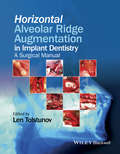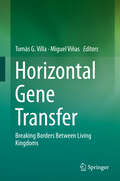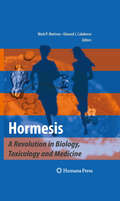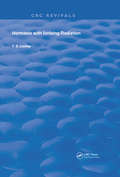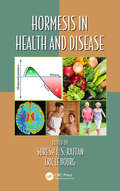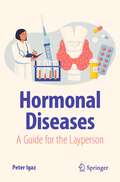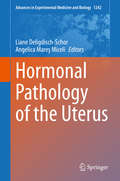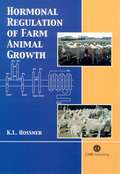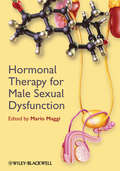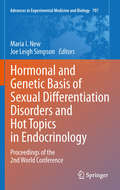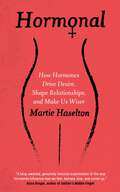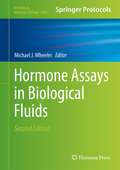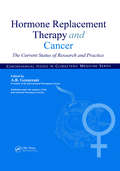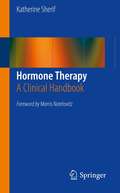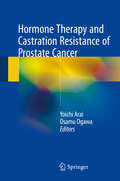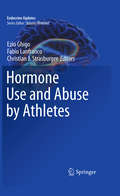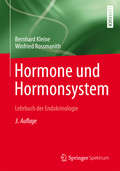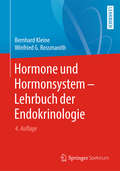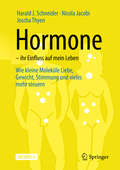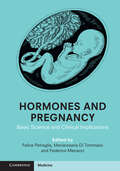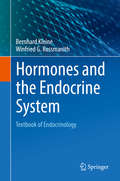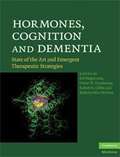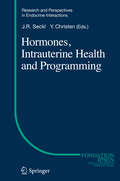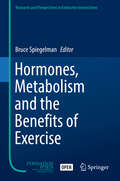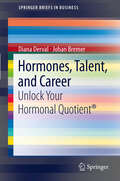- Table View
- List View
Horizontal Alveolar Ridge Augmentation in Implant Dentistry
by Len TolstunovHorizontal Augmentation of the Alveolar Ridge in Implant Dentistry: A Surgical Manual presents the four main methods of horizontal ridge augmentation in a clinically focused surgical manual. After an introductory section and requirements for dental implants, sections are devoted to each procedure: Ridge-split, intraoral onlay block bone grafting, guided bone regeneration, and horizontal distraction osteogenesis. Chapters written by international experts in each augmentation procedure Step-by-step instruction for each technique More than 1,100 clinical photographs and illustrations
Horizontal Gene Transfer: Breaking Borders Between Living Kingdoms
by Tomás G. Villa Miguel ViñasThe book focuses on the evolutionary impact of horizontal gene transfer processes on pathogenicity, environmental adaptation and biological speciation. Newly acquired genetic material has been considered as a driving force in evolution for prokaryotic genomes for many years, with recent technical developments advancing this field further. However, the extent and implications of gene transfer between prokaryotes and eukaryotes still raise controversies. This multi-authored volume introduces various means by which DNA can be exchanged, covers gene transfer between prokaryotes and their viruses as well as between bacteria and eukaryotes, such as fungi, plants and animals, and addresses the role of horizontal gene transfer in human diseases. Aspects discussed also include the relevance for virulence and drug resistance development on one hand, and for the occurrence of naturally derived antibiotics and other secondary metabolites on the other hand. This book offers new insights to anyone interested in genome evolution and the exchange of DNA between the different domains of life, the genetic toolkit for adaptation and the emergence of multidrug resistant bacteria.
Hormesis
by Edward J. Calabrese Mark P. MattsonThis book stems from the belief that scientists and policy makers should be guided by the most reliable predictive models available, among which the hormetic dose response model has considerable evidence to support it, is very generalizable, has a strong mechanistic foundation and can be applied in the assessment of single agents and complex mixtures. For these reasons, the hormetic model should become the default in risk assessment. This book summarizes and analyzes the various positives of hormesis in an attempt to revel hormesis as a fundamental principle of toxicology, biology, and biomedical sciences as a whole. A focused discussion of how acceptance of the hormedis based model of toxicology would affect environmental standards and clean up values is mounted. A panel of scientists has been recruited to critically evaluate the hormetic dose response model and its comparison with current default models in their individual fields, including cellular biology, evolutionary biology, gerontology, and pharmacology. In-depth investigations are provided into how biological systems respond to increasing doses of environmental toxins while attempting to understand how cells respond to stress in the contexts of aging and neurological disorders.
Hormesis With Ionizing Radiation (Routledge Revivals)
by T. D. LuckeyFirst published in 1980: The purpose of this Monograph, Hormesis With Ionizing Radiation, are to crystalize scattered information into an accepted subject of science and to awaken our society to new potential uses of ionizing radiation.
Hormesis in Health and Disease (Oxidative Stress and Disease)
by Suresh I. S. Rattan Éric Le BourgSome mild stresses have positive effects on survival and aging as shown in animal models. There is also a large body of research that demonstrates these hormetic effects on aging, health, and resistance to severe stresses and diseases in human beings. However, the data are dispersed in the literature and are not always interpreted as hormetic effec
Hormonal Diseases: A Guide for the Layperson (Copernicus Books)
by Peter IgazWritten by a recognized expert in the field, this accessible book acquaints the lay reader with the main features of hormonal diseases, their diagnosis and treatment. From gigantism and dwarfism to polycystic ovary syndrome, overactive thyroid and many more; it also explains what specialists in endocrinology do - and why - when diagnosing and treating patients.Each chapter gives a short introduction to the relevant hormonal disease, with information about the symptoms, diagnosis and treatment presented in an easily comprehensible question and answer format. Simple but accurate diagrams are used to visualize the information. The book clarifies important issues and helps patients to make informed decisions. Last but not least, it includes some current hot topics in endocrine practice as well as fascinating historical facts. It is a must-read for everyone interested in the fascinating world of hormones and their disorders.
Hormonal Pathology of the Uterus (Advances in Experimental Medicine and Biology #1242)
by Liane Deligdisch-Schor Angelica Mareş MiceliHormonal influences, both natural and iatrogenic, are implicated in the most frequent health issues of women. Endometrial cancer is now the most common gynecologic cancer in the United States and the industrialized world. This cancer is strongly related to hormonal and metabolic factors. In addition, breast cancer treated with hormone therapy (Tamoxifen) may, in some cases, be associated with uterine pathology. Hormone therapy is used to improve the physiological effects and counteract abnormal and deleterious effects of “natural” hormonal activity. Millions of women receive hormone therapy at some point of their life: using oral contraceptives, reproductive technology, treatment for post-menopausal symptoms, among other uses. This book addresses a range of women’s health issues, from fertility to neoplasms, and their relationship with natural and iatrogenic hormonal effects. Chapters include clinical and pathological descriptions, theoretical and practical medical issues, and original studies and cases. Controversial issues in certain hormone therapies are presented with updated concepts based on clinical studies and novel statistical methods. The book will be useful for specialized and general physicians, oncologists, endocrinologists, researchers, medical students, and others in the field of women’s health.
Hormonal Regulation of Farm Animal Growth
by K. L. HossnerHossner (animal sciences, Colorado State U.) describes the regulation of farm animal growth by hormones and growth factors. The focus is on developmental, cellular, and molecular mechanisms regulating the growth and differentiation of skeletal muscle, bone, and adipose tissue. Suitable for advanced undergraduate and graduate animal science courses, the text assumes some background knowledge of biochemistry and cell biology. Annotation ©2006 Book News, Inc., Portland, OR (book news.com)
Hormonal Therapy for Male Sexual Dysfunction
by Mario MaggiHormonal therapy offers a potentially powerful approach to the treatment of sexual disorders in men. However the interplay of different hormones within different bodily systems is carefully balanced; judicious judgement is required in the therapeutic use of hormones to minimize unwelcome side effects.A better understanding of how hormones work will help the physician to better tailor therapies for improved sexual responses in men. Hormonal Therapy for Male Sexual Dysfunction will provide the rationale for hormonal therapy in male sexual disorders, explaining the language of sexual endocrinology and its application in clinical practice.The aim of this book is to provide a clinical 'in the office' or 'at the bedside' guide to effective patient care for sexual medicine physicians, urologists, gynecologists and other health-care providers in practice and in training. The tone will be practical, not academic. The working assumption is that readers want to know what (and what not) might or should be done, without over emphasis on the why. That said, it is important to review the crucial basic science necessary for effective diagnosis and management, and to provide reminders in the context of the practical chapters.It will not be heavily referenced, in line with a more practical approach. This allows for smoother reading (and also relieves the burden of comprehensive citing from authors). Key evidence (clinical trials, Cochrane or other meta analyses) should be summarized in 'Evidence at a Glance' boxes and key references such as reviews, major papers can be provided in the 'selected bibliography' at the end of each chapter. Practical guidance will be provided through:- the use of algorithms and guidelines where they are appropriate- 'Tips and Tricks' boxes - hints on improving outcomes perhaps via practical technique, patient questioning etc- 'Caution' warning boxes - hints on avoiding problems, perhaps via contraindications- 'Science Revisited' - quick reminder of the basic science principles necessary for understanding
Hormonal and Genetic Basis of Sexual Differentiation Disorders and Hot Topics in Endocrinology: Proceedings of the 2nd World Conference
by Maria I. New Joe Leigh SimpsonProceedings of the 2nd World Conference - Hormonal and Genetic Basis of Sexual Differentiation Disorders and Hot Topics in Endocrinology. The meeting took place at The Eden Roc Hotel in Miami Beach, Florida, 1/15/10 - 1/17-10. Endocrinology and more specifically, the area of sexual differentiation disorders is an evolving field of medicine. The diagnosis and treatment of Disorders of Sex Development (DSD) is multi-faceted.
Hormonal: How Hormones Drive Desire, Shape Relationships, and Make Us Wiser
by Martie HaseltonProvocative, ground-breaking and entertaining, the world&’s leading expert on sexuality and the ovulation cycle reveals the hidden intelligence of hormones.In this paradigm-shifting book, Martie Haselton explains how hormonal intelligence works - both its strengths and its weaknesses - and shows women how to track and understand their desires, fears and perceptions with a radical new understanding of the biological processes that profoundly influence our behaviour. Rigorously researched, entertaining and empowering, Hormonal offers women deep new insights into their bodies, brains and relationships, and will encourage women everywhere to embrace the genius of female biology.
Hormone Assays in Biological Fluids
by Michael J. WheelerHormone measurement is necessary for the diagnosis of a wide range of clinical conditions and is essential for monitoring the effectiveness of treatment. As the number of hormone requests in the clinical field rises exponentially, it has become imperative to create hormone assays accessible to researchers with a varied range of equipment. Hormone Assays in Biological Fluids, Second Edition reviews common techniques used to measure hormones as well as relatively new methods such as tandem mass spectrometry. Additionally, subsequent chapters detail methods for a broad range of hormones; Techniques and principles covered are transferable to a wide range of substances across species. Written in the successful Methods in Molecular Biology series format, chapters include introductions to their respective topics, lists of the necessary materials and reagents, step-by-step, readily reproducible protocols, and notes on troubleshooting and avoiding known pitfalls. Authoritative and easily accessible, Hormone Assays in Biological Fluids, Second Edition will serve students, technologists, laboratory scientists, and researchers looking to apply, or attain a greater understanding of, methods for measuring hormones.
Hormone Replacement Therapy and Cancer: The Current Status of Research and Practice
by Andrea R. GenazzaniThe clinical benefits of hormone replacement therapy in women have to be carefully balanced against the possible risks, and a particular theoretical concern relates to risks associated with various forms of female oncology. Because of conflicting reports, gynecologists and oncologists especially need a single, authoritative resource of up-to-date information. Hormone Replacement Therapy and Cancer, published in association with the International Menopause Society, provides the very consensus statement that clinicians need in this difficult and complex area. Many of the world's leading specialists have contributed important chapters that provide state-of-the-art knowledge about the effects of hormones on women and possible cancer risks. The introductory section deals with carcinogenesis, and the other main sections cover HRT and breast cancer, endometrial cancer, colon cancer, melanoma and epithelial ovarian cancer. The concluding chapters discuss the benefits and risks of sp ecific therapies. An authoritative clinical reference with extensive bibliographic references and index, Hormone Replacement Therapy and Cancer covers all aspects of HRT and cancer based on the research available up to June 2001.
Hormone Therapy
by Katherine SherifHormone Therapy: A Clinical Handbook provides a comprehensive overview on hormone replacement therapy, with a range of key features that differentiate it from other titles on the topic. This concise, handy title presents an interdisciplinary approach to the subject, acknowledging that sex hormones affect more than reproductive organs and hot flushes for a deeper understanding of how hormones function. The authors provide a breadth and depth of practical prescribing experience, including many helpful tables and algorithms as well as directions for prescribing hormone therapy in the most effective and safest ways possible. Targeted and easy to read, Hormone Therapy: A Clinical Handbook offers all clinicians the state-of-the-art information they need to prescribe hormone therapy and hormone replacement therapy.
Hormone Therapy and Castration Resistance of Prostate Cancer
by Yoichi Arai Osamu OgawaThis comprehensive reference expounds the current state of hormone therapy and castration resistance of prostate cancer (PCa). Previously, the incidence of PCa in Asian countries was relatively low, but it has been increasing dramatically in recent years. Although most of the new cases are diagnosed in early stages, a significant proportion of patients receive hormone therapy for metastatic disease or for relapse after local treatment. Thus the situation has gradually changed toward earlier and longer use of hormone therapy. The malignancy finally forms castration-resistant prostate cancer (CRPC) despite the lack of testicular androgen. With advances in understanding of the molecular basis of hormone dependence and CRPC, many new androgen receptor-targeted agents have emerged. During the last decade, much evidence on hormone therapy has been accumulated in Japan. Interestingly, some of these findings are different from those reported from Western countries, suggesting ethnic variation in the outcome of hormone therapy. In the chapters of this book, expert authors provide exhaustive interpretations of the evidence recently reported from Japan and provide important Asian perspectives on hormone therapy for PCa. This work benefits not only Asian urologists but also their Western counterparts and all physicians and medical personnel who are involved in the treatment of PCa.
Hormone Use and Abuse by Athletes
by Fabio Lanfranco Ezio Ghigo Christian J. StrasburgerPhysical activity exerts an important influence on the endocrine system, modulating synthesis and secretion of several hormones. Almost every organ and system in the body is affected by physical activity and exercise, mainly through the endocrine and neuroendocrine system. Mode, intensity, and duration of the exercise bout, age, gender and fitness level of the individual as well as environmental and psychological factors may affect the endocrine response to physical activity. On the other hand, several hormones are able to influence physical performance and body composition. Thus, a bi-univocal interrelationship between exercise and hormones exists. In this book new developments on metabolic and endocrine response to exercise are revised and introduce the "hot topic" of hormonal doping in sports. In the past decades, hormone abuse has become a widespread habit among professional and - most of all and more frequently - recreational athletes. A substantial part of this volume is devoted to the effects of exogenous hormones on performance. Anabolic steroids, growth hormone and erythropoietin properties, use and misuse in sports are widely described. Specific methods to detect hormone abuse are presented and discussed. The contributors to this volume are well-known experts and dedicated researchers in the fields of sports medicine and endocrinology, endocrine physiology, pharmacology, and doping detection. The purpose of this volume is to provide all professionals involved in sports medicine and endocrinology a state-of-the-art overview of the complex interactions between physical activity and the endocrine system and to focus on hormone abuse in sports at competitive and recreational level highlighting its negative consequences for long-term health.
Hormone und Hormonsystem - Lehrbuch der Endokrinologie
by Bernhard Kleine Winfried RossmanithGrundlagen und neue Entwicklungen Die technischen Fortschritte und neuen Möglichkeiten der molekularen Biologie - Genomanalysen, Expressionsanalysen, konfokale Lasermikroskopie, Proteomics - lassen die Physiologie von Wirbeltieren, genauso wie die von Nicht-Wirbeltieren, in einem neuen Licht erscheinen. Bei der Darstellung der Endokrinologie von Mensch und Tier wird dieser Entwicklung Rechnung getragen: Die Schwergewichte liegen auf Hormonbiochemie, Hormonphysiologie, Hormonrezeptoren, endokrinen Organen und Regelkreisen und der Regelung endokriner Rhythmen. Die Betrachtung des Hormonsystems reicht von seinen Ursprüngen bei Invertebraten, seiner Evolution, den Wechselwirkungen mit Nerven- oder Immunsystem bis zu Stoffwechselstörungen bei menschlichen Gen-Defekten. In der 3. Auflage sind nun alle Abbildungen in Farbe. Der Text ist komplett aktualisiert, weitere Hormonsteckbriefe sind hinzugekommen und der Abschnitt steroidogene Enzyme ist komplett überarbeitet. Alles verständlich und kompakt in einem Buch!
Hormone und Hormonsystem - Lehrbuch der Endokrinologie: Lehrbuch Der Endokrinologie (Springer-lehrbuch Ser.)
by Bernhard Kleine Winfried RossmanithDie technischen Fortschritte und neuen Möglichkeiten der molekularen Biologie – Genomanalysen, Expressionsanalysen, konfokale Lasermikroskopie, Proteomics – lassen die Physiologie von Wirbeltieren, genauso wie die von Nicht-Wirbeltieren, in einem neuen Licht erscheinen. Bei der Darstellung der Endokrinologie von Mensch und Tier wird dieser Entwicklung Rechnung getragen: Die Schwerpunkte liegen auf Hormonbiochemie, Hormonphysiologie, Hormonrezeptoren, endokrinen Organen und Regelkreisen und der Regelung endokriner Rhythmen. Die Betrachtung des Hormonsystems reicht von seinen Ursprüngen bei Invertebraten, seiner Evolution, den Wechselwirkungen mit Nerven- oder Immunsystem bis zu Stoffwechselstörungen bei menschlichen Gen-Defekten. Die 4. Auflage ist deutlich erweitert. Das Thema Stoffwechsel nimmt, verteilt über mehrere Kapitel, eine wesentlich größeren Raum ein. Komplett neu ist auch die Embryologie der endokrinen Organe.
Hormone – ihr Einfluss auf mein Leben: Wie kleine Moleküle Liebe, Gewicht, Stimmung und vieles mehr steuern
by Harald J. Schneider Nicola Jacobi Joscha ThyenOb Schwangerschaft, Wechseljahre, Verliebtsein oder Pubertät: Oft heißt es, die Hormone spielen verrückt. Doch weit gefehlt: Hormone, die Boten unseres Körpers, beeinflussen unser Leben von der ersten Sekunde an. Nur wenn sie tun, was sie tun sollen, funktioniert unser Körper, wie er soll. Zu wissen, wie das menschliche Hormonsystem arbeitet, ist nicht nur spannend, sondern hilft auch dabei, den eigenen Körper und die eigenen Gefühle und Handlungsweisen besser zu verstehen. Dieses Buch bietet gut verständliches Fachwissen, ausführlich erklärt und kompakt zusammengefasst. Es liefert Informationen zu hormonellen Störungen und beantwortet Fragen, die sich viele von uns schon einmal gestellt haben: Warum bin ich zu dick? Warum bin ich zu dünn? Warum fallen mir hier die Haare aus und habe ich dort zu viele? Warum schwitze ich so viel? Warum bleibt meine Periode aus? Warum bin ich dauernd müde? Sind's vielleicht die Hormone? Ganz nebenbei erfährt man auch, warum unser Hormonsystem aus der Steinzeit stammt und wieso das heute ein Problem sein kann, was Goliath mit einer Hormonstörung zu tun hatte oder warum „Mann“ nicht immer kann. Prof. Harald J. Schneider ist Facharzt für Endokrinologie. Seit 2000 behandelt er tagtäglich Patienten, die mit diesen und vielen anderen Fragen in seine Praxis kommen. Nicola Jacobi ist ausgebildete Journalistin und freie Autorin für verschiedene Medien. Sie ist aber auch Betroffene und beschäftigt sich deswegen seit vielen Jahren mit diesem Thema.
Hormones and Pregnancy: Basic Science and Clinical Implications
by Felice Petraglia Mariarosaria Di Tommaso Federico MecacciThe endocrine and neuroendocrine system in pregnancy involves highly complex maternal, fetal and placental mechanisms, which are critical for the maintenance of pregnancy, the timing of parturition, for fetal growth and protection from adverse fetal programming. This timely book summarizes the different endocrine aspects related to pregnant women, describing how hormones regulate physiological homeostasis and influence the pathogenesis of disease. The first section of the book covers the role of specific hormones in detail, including oxytocin, hCG and estrogen. The second section discusses gestational disorders such as diabetes, hypertensive disorders and preeclampsia and how the involvement of hormones has clinical implications for management. Best practice for management of endocrine disorders, which can negatively impact pregnancy, such as thyroid disease and obesity, is also reviewed. This book is essential for clinicians and scientists looking to gain knowledge of the role of hormones in pregnancy and how they can best support patients.
Hormones and the Endocrine System
by Bernhard Kleine Winfried G. RossmanithThis book focuses on hormones, and on how they are produced in very diverse regions of the body in humans and animals. But hormones can be found not only in vertebrates, but also in insects, shellfish, spiders, mollusks, even at the origin of metazoan diversification and exhibit the same pathways of synthesis. The book addresses the different classes of hormones: protein/peptides hormones, steroids and juvenile hormones and hormones like catecholamines, thyroid hormones and melatonin. It also discusses the types of hormone receptors, the majority of which are heptahelical G-protein coupled receptors or nuclear receptors. Particular attention is paid to the organs where hormones are created, with specifics on hormonal production and release, while a dedicated chapter details hormonal regulation from very simple to highly complex schemes. The remarkable kinetics of hormones production are also shown, before the book is rounded out by chapters on evolution in the endocrine system, the genetics of endocrine diseases and doping.
Hormones, Cognition and Dementia: State of the Art and Emergent Therapeutic Strategies
by Eef Hogervorst Victor W. Henderson Robert B. Gibbs Roberta Diaz BrintonA decade ago, estrogen-containing hormone therapy was viewed as a promising strategy for the prevention and treatment of dementia and age-related cognitive decline. However, treatment trials in women with Alzheimer's disease showed that estrogens did not reverse cognitive impairment, and clinical trials in healthy older women indicated that estrogens did not prevent cognitive decline. The Women's Health Initiative Memory Study trial even suggested an increased risk of dementia with treatment late in life. What happened? How are we to understand these findings? What are the implications for middle-aged and older women? What about testosterone, and what about men? And where do we go from here? This book brings together world-renowned experts in basic and clinical research on sex steroids, aging, and cognition to integrate existing findings with emerging new data, and offer challenging hypotheses on these key issues.
Hormones, Intrauterine Health and Programming
by Jonathan R Seckl Yves ChristenThe authors address in particular the role of hormones and their links with other maternal environmental mediators in developmental programming. The crucial nature of the placenta as an interface and target between maternal and foetal environments is addressed. Emphasis is made on the emerging science of epigenetics as a potential explanation for how environmental events that occur during brief windows of development may exert effects that impact upon somatic cells through many rounds of mitosis for much of the life span of the subsequent organism.
Hormones, Metabolism and the Benefits of Exercise (Research And Perspectives In Endocrine Interactions Ser.)
by Bruce SpiegelmanThe world is faced with an epidemic of metabolic diseases such as obesity and type 2 diabetes. This is due to changes in dietary habits and the decrease in physical activity. Exercise is usually part of the prescription, the first line of defense, to prevent or treat metabolic disorders. However, we are still learning how and why exercise provides metabolic benefits in human health. This open access volume focuses on the cellular and molecular pathways that link exercise, muscle biology, hormones and metabolism. This will include novel “myokines” that might act as new therapeutic agents in the future.
Hormones, Talent, and Career: Unlock Your Hormonal Quotient®
by Diana Derval Johan BremerThe media now regularly feature breakthroughs on the influence of prenatal hormones on the brain and behavior, for instance the link to financial performance or risk management. Based on these findings and their own experiments, the authors present the Hormonal Quotient (HQ) as a scientific, holistic and reliable career management and personal development tool for professionals. Eight HQ profiles and their corresponding typical business skills and preferences are presented and enable the reader to benchmark their HQ with peers, design an ideal career plan, build a winning team in business and find the perfect work-life balance. A complimentary website allows readers to easily measure their HQ online. By the author of "The Right Sensory Mix", Berry-AMA Book Prize Finalist 2011.
